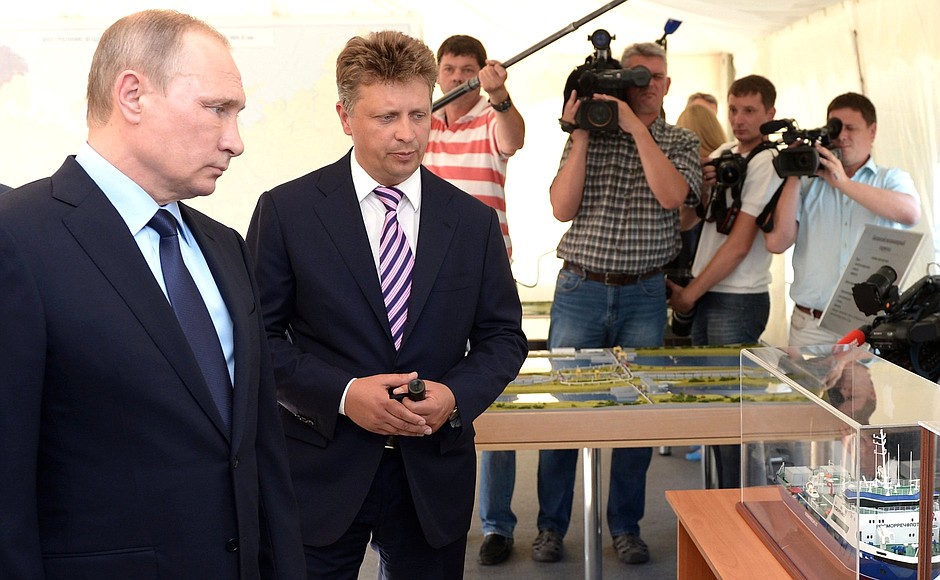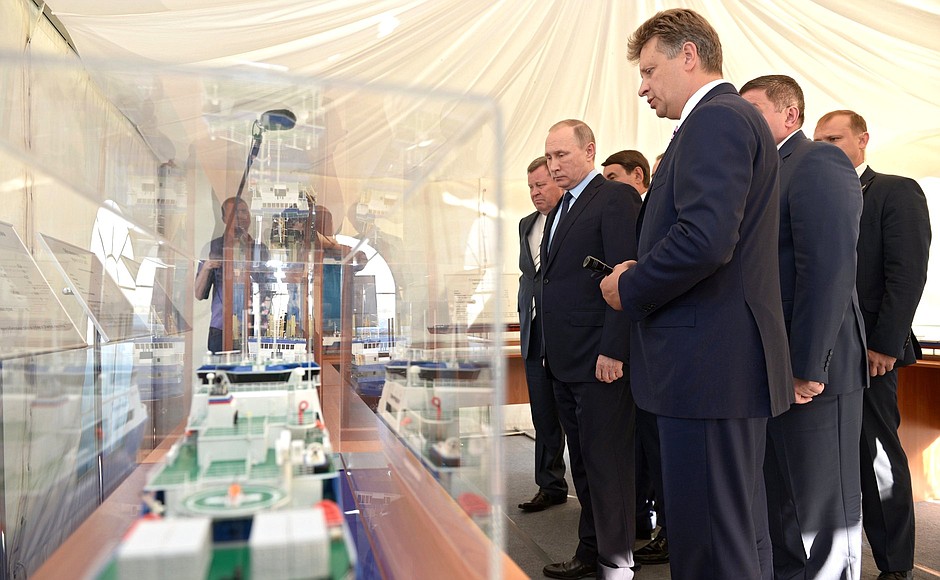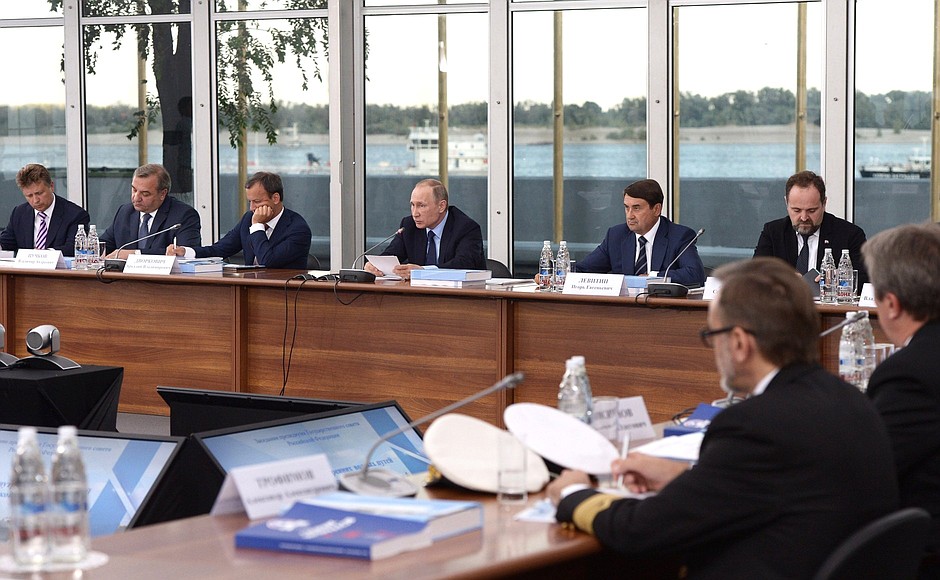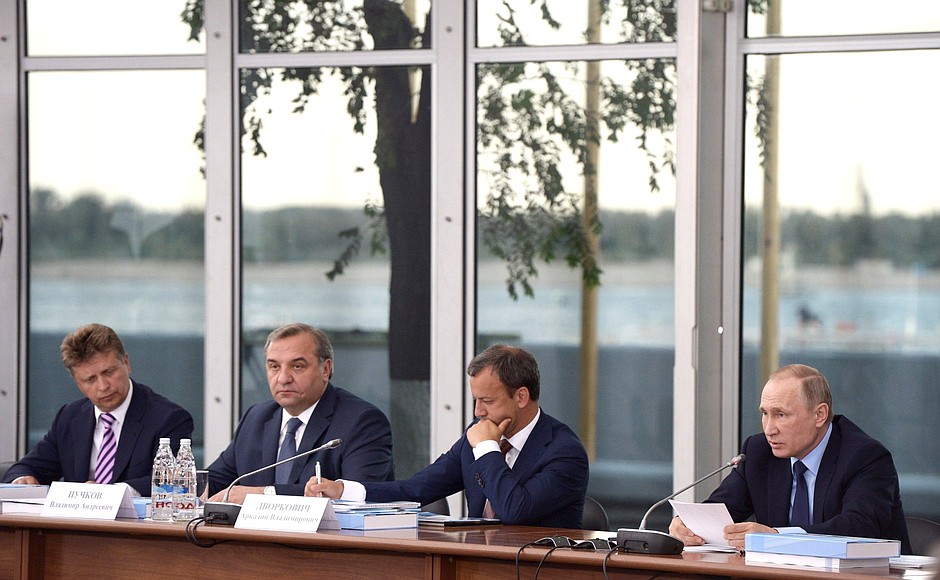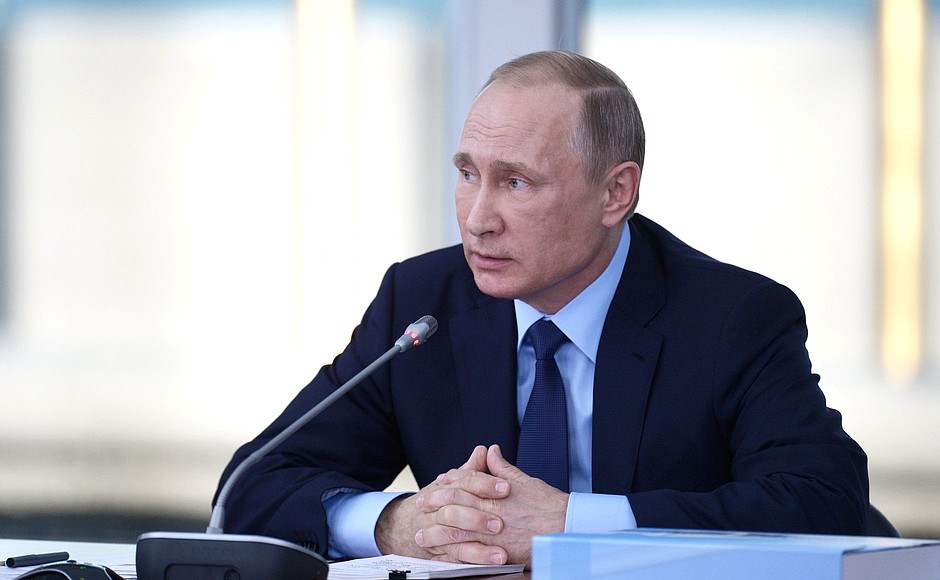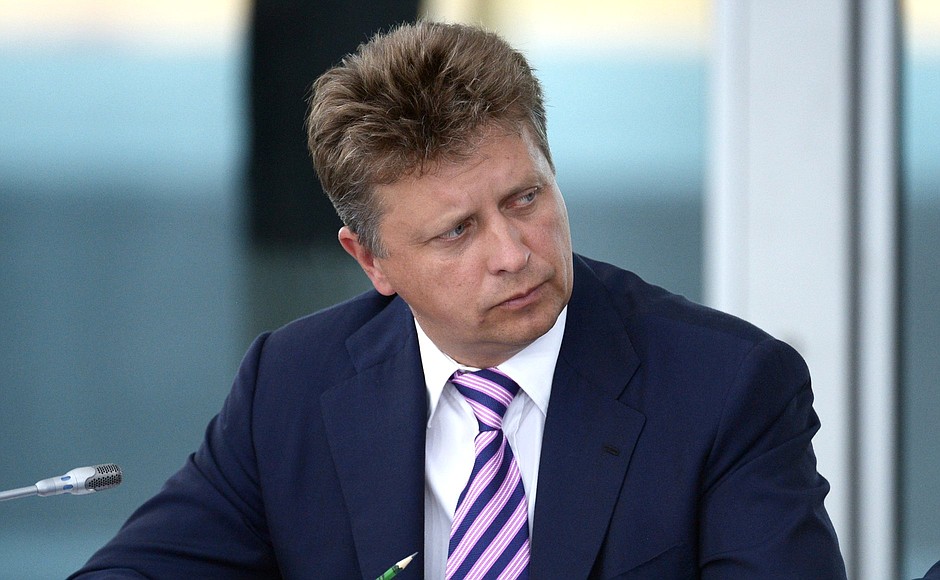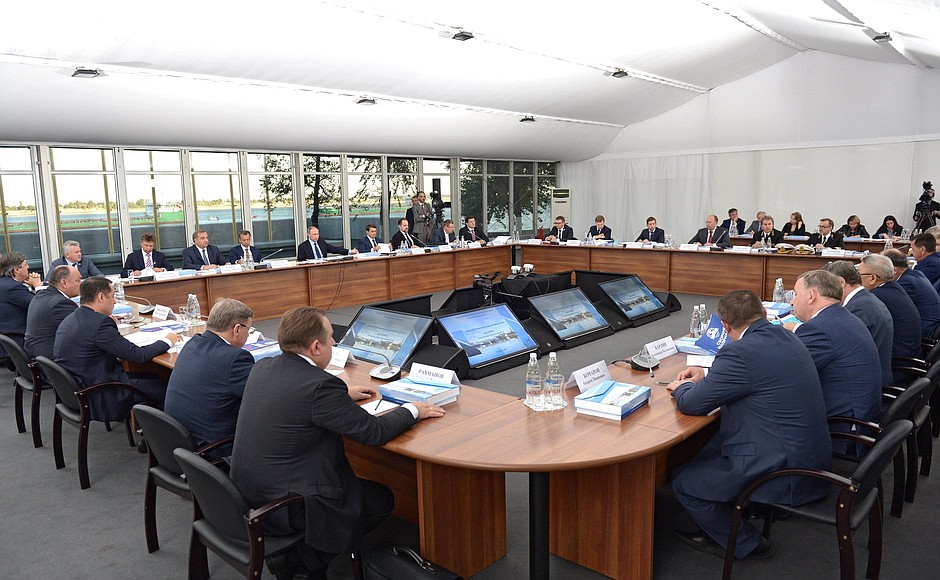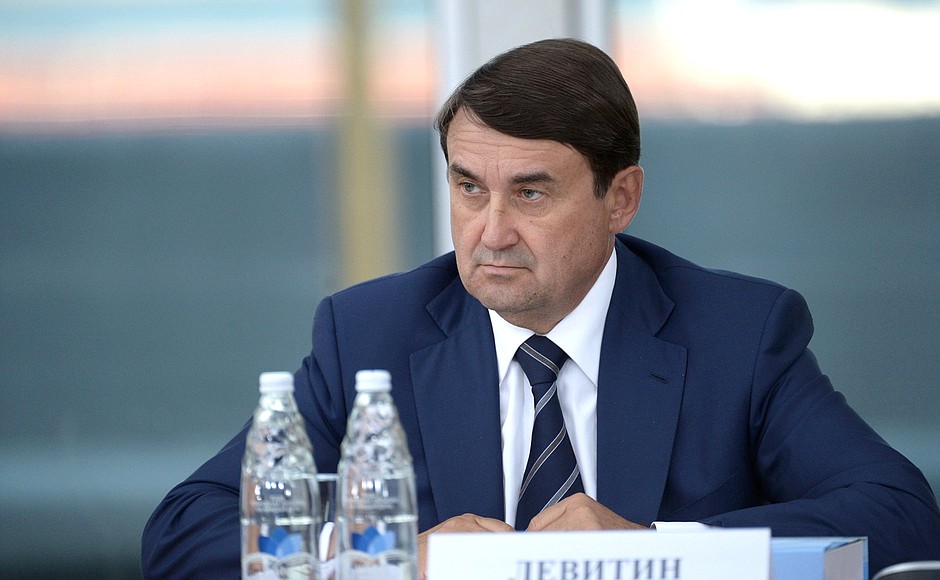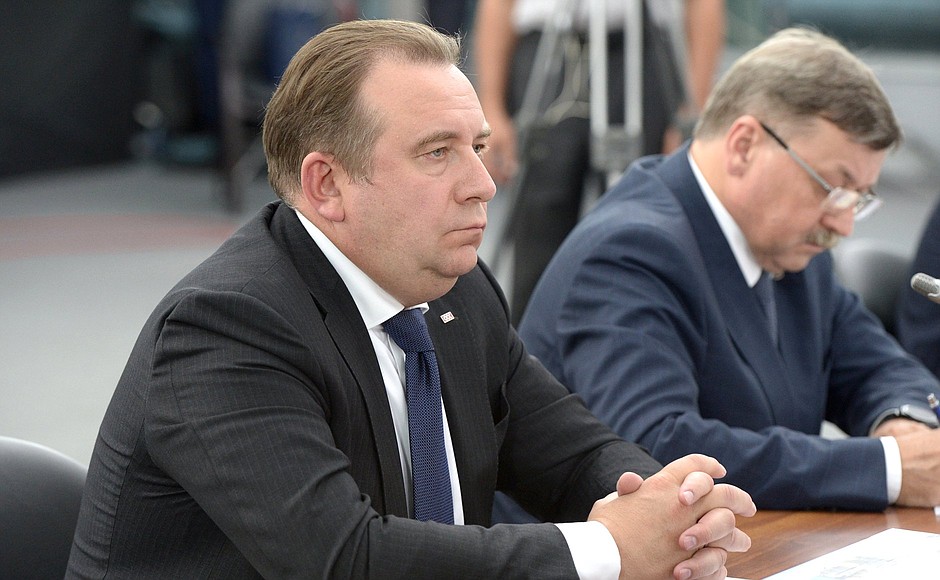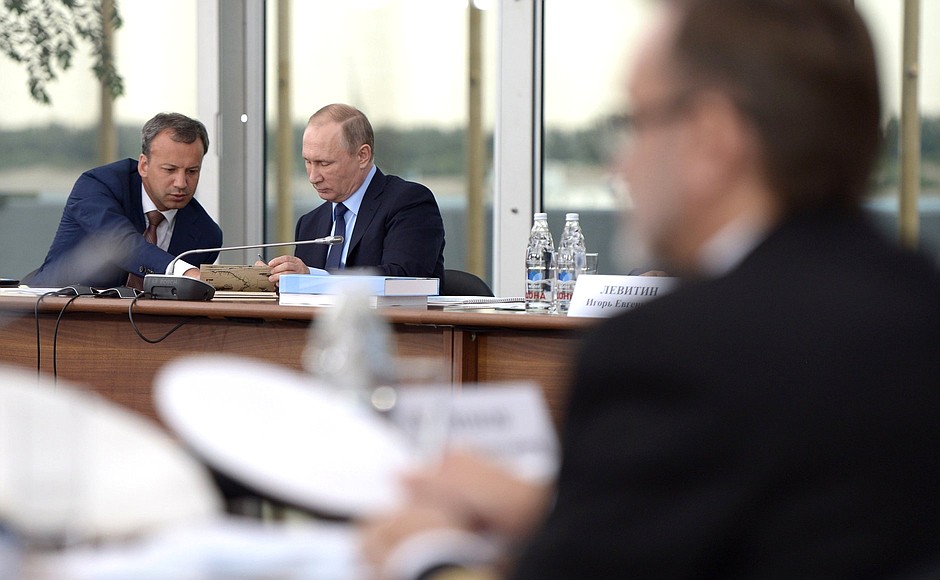Before the meeting, the President visited the exhibition Water Transport – Today’s Goals and Tomorrow’s Prospects, which displayed, among other things, models of river ships of various types, both currently in the design phase and already in production, and models of the Bagayevsky and Nizhny Novgorod hydro-power installations currently in the design stage. Transport Minister Maxim Sokolov provided explanations.
Excerpts from transcript of the State Council Presidium meeting on developing Russia’s internal waterways
President of Russia Vladimir Putin: Good afternoon colleagues.
We are here in Volgograd today, on the banks of the Volga. This is not by chance, because on our agenda today is the question of developing Russia’s internal waterways. This is a very important matter not just for the Volga region but for the whole country.
Our navigable waterways cross 60 Russian regions, which are home to 80 percent of the population and produce up to 90 percent of the GDP.
The density of our waterways is comparable to the railway network. These are not just transport arteries stretching for 100,000 kilometres; they have a complex purpose and play a part in key sectors such as hydropower, housing and utilities, and agriculture.
Our waterways have a complex purpose and play a part in key sectors such as hydropower, housing and utilities, and agriculture.
Before the railways arrived, the waterways were Russia’s main lines of transportation, used to carry cargos and passengers. The rivers, and the canals that have been added, continue today to support extensive contacts between regions and people, playing a big part in strengthening Russia’s common economic space and helping to develop international cooperation.
The internal waterways have substantial competitive potential. They offer cheap shipping, especially over long distances, are energy efficient, and their maintenance costs are relatively low. I say relatively, because even at such relatively low costs funding needs to be allocated on a timely basis.
Many parts of the country simply have no alternative to river transport, especially the northern regions that rely on supplies brought in by river transport to get through the winter.
I spoke with the head of Yakutia this morning, and he said that winter supply work is going to plan and without problems, but this is not always the case, including because of issues with the condition of the rivers. However, we are not making full use of the many advantages the waterways offer. Russia’s Transport Strategy through 2030, for example, notes that waterways lag considerably behind other types of transport.
We are here today to analyse the problems in this area and discuss the obstacles to developing this crucially important area and the measures we need to take to solve these problems now and in the future.
Let me say a few words about what I think are the most important issues.
The rivers, and the canals that have been added, continue today to support extensive contacts between regions and people, playing a big part in strengthening Russia’s common economic space and helping to develop international cooperation.
First, we need to overcome the infrastructural bottlenecks. Primarily this is the depth of waterways, which has decreased by a quarter on average over the past 25 years, while the length of waterways that can provide guaranteed passage for shipping has decreased by 30 percent. Adding to these problems is the shallowness of some rivers, which means that more than half the ships using the waterways cannot carry full loads. This leads to losses and an increase in the number of loss-making journeys, and the result is that freight volumes transported via the waterways have fallen 3.3-fold. In 1990, water transport was comparable to road transport in terms of freight volumes, but now there is a four-fold gap between them. In 1980, for example, a total 481 million tonnes of cargo was transported via the waterways, while the figure was only slightly more than 120 million tonnes in 2015. Passenger transport on the waterways has also dropped sharply. It stood at 103 million people in 1980, but was only 13.5 million in 2015.
We have quite a few of these bottlenecks in our unified deep-water waterway system today, places where the depth is now a lot less than the minimum depth required for shipping. This has led to division of the Volga and the Lower Don into separate stretches. We have just spoken with the Governor about how this year the water level is looking quite good and seems to be sufficient, but this is far from always the case.
Insufficient water levels have led to practically a complete halt in through shipping for freight and passenger ships on these rivers. We have lost the popular through routes from St Petersburg and Moscow to a number of our southern regions, routes that were especially attractive for tourists from abroad. We should give priority support to projects in this area. All stages of project and expert evaluation should be carried out in close contact with the environmental protection agencies and the leading environmental protection organisations. The natural environment of the Volga and of our other rivers is invaluable and truly unique and we must do everything we can to minimise and avoid entirely any possible damage.
We should also reflect on what we can do to revive and stimulate river cruise tourism, including for foreign tourists, as I have said. One of the key issues here is to improve the visa regulations, and I would like to hear proposals in this area as well.
The internal waterways have substantial competitive potential. They offer cheap shipping, especially over long distances, are energy efficient, and their maintenance costs are relatively low.
The second priority is to achieve a balance between the different types of transport and thus reduce not only budget expenses but also shippers’ costs. We know that shipping a tonne of goods via the waterways costs a lot less than by road.
More than a quarter of federal highways are overloaded today, especially in the summer period when people are heading off on or returning from their holidays, and you have to share the roads with all this freight transport carrying gravel and sand, and all this when the rivers are open to navigation. These are possibilities we are hardly using at all or are using inefficiently.
To be honest, we have already discussed this matter in the past and the Government was instructed to examine this issue in April 2014. The shipping companies are not in any hurry to change their usual logistics and continue doing things as they are used to doing. The Government will need to take urgent measures to encourage river transport.
Let me add that in China, where the length of the waterways is comparable to ours, slightly more than ours, they ship 12 times more cargo along waterways than we do. If we compare the use of waterways and of other types of transport, Russia’s freight water transport is lower even than in countries where the length of waterways is much less, European countries such as the Netherlands, Germany and France, for example. The waterways play a big part in these countries despite the existence of highly developed road transport systems.
We need to develop our port infrastructure and build modern container terminals. I would like to add that the Government approved regulations for the maintenance of internal waterways back in 2014. Clearly, fully reaching these goals and objectives and rebuilding the technical facilities on the waterways for shipping will require additional financing and this is something we must also reflect on. I hope we will discuss this today as well.
We have lost the popular through routes from St Petersburg and Moscow to a number of our southern regions. We should give priority support to projects in this area. All stages of project and expert evaluation should be carried out in close contact with the environmental protection agencies and the leading environmental protection organisations.
The third priority is to modernise the river fleet. I have just heard about the latest developments from the head of our shipbuilding company, and overall, the pace of work in this area is still too slow, unfortunately. Over the past 15 years, we have built 800 ships, but this is not enough to cover the scope of work carried out by the ships that were taken out of service. Thirteen times more ships have been taken out of service than new ships added. In 2000, we had 21,000 transport vessels working on our rivers, but now we have only 11,000 remaining, and their average age exceeds 36 years.
Modernising the river fleet is a complicated matter and we have discussed it before and taken decisions. I want to hear how they are being implemented.
There are big issues with the operation of our port facilities too, especially the wharves. Aging reinforced concrete structures that do not meet modern technical standards and are often not particularly safe for passengers are a big problem. The wharves are usually state-owned and not used commercially. There is usually never enough money in the budgets for their repair and reconstruction. This hampers the development of passenger and tourism transport. It is clear that we need to put these facilities to commercial use to attract private money, private capital and business to their development. I would like to hear your proposals on this as well.
Effective use of the waterways and their infrastructure is a topical issue now. Hydropower station dams limit the free flow of rivers. This places an added burden on other water users. Many different economic sectors’ interests meet when it comes to river use, and this is the main cause of the problems. Federal agencies look only to their own narrow interests and their decisions often contradict each other. It is a common situation when each pulls the blanket their way and the quality of the waterways and the state of their infrastructure does not always benefit as a result.
We know that shipping a tonne of goods via the waterways costs a lot less than by road. More than a quarter of federal highways are overloaded today, and all this when the rivers are open to navigation. These are possibilities we are hardly using at all or are using inefficiently.
We clearly need better-coordinated work among the agencies. We have an organisation with the necessary powers in this area: the Government Commission for Natural Resources and Environmental Protection. True, as far as I know, it has not yet given due attention to the waterways issue. I hope that this meeting and its decisions will activate the commission’s work.
Let me raise one last issue in conclusion. July 10 was the 5th anniversary of the tragedy that befell the river cruise ship Bulgaria. We all remember that terrible tragedy and know its causes. Much has been done since then to make sure this never happens again, but we must keep safety issues under our constant attention of course. I particularly stress the need to use modern navigation technologies that not only make waterway use more efficient but also help prevent possible accidents and allow for real-time shipping monitoring. I would like to stress that safety always has to come first and this is something we should never neglect.
Colleagues,
Our work begins today with a direct link-up to Astrakhan, for the keel laying of a new river-sea passenger cruise ship at a local shipyard. We have just seen what this ship will look like. Let us hear from our colleagues. Astrakhan, you have the floor.
There are big issues with the operation of our port facilities, especially the wharves. This hampers the development of passenger and tourism transport. It is clear that we need to put these facilities to commercial use to attract private money, private capital and business to their development.
Vice President of Unified Shipbuilding Company Yevgeny Zagorodny: Colleagues,
Reviving Russia’s passenger river and sea fleet is one of the shipbuilding sector’s top priorities. Today, the Lotos shipyard is keel-laying a PV300 river-sea ship that will be without precedent in Russian passenger shipbuilding.
We have not built ships of this class for more than 60 years. The work on this new vessel will act as a catalyst for taking sea and river cruises to a new level. In essence, we are witnessing the revival of our shipbuilding skills. The Moscow Shipping Company placed the order for the ship, which will be built at the Lotos shipyard in cooperation with the Krasnoye Sormovo plant. This is the start of what will be a long-running series.
I am sure that your good wishes and our work will guarantee that we will be able to speak of Russia’s fleet with pride.
We begin the keel-laying of the River-Sea PV300 ship.
Vladimir Putin: Go ahead, Mr Zagorodny.
Yevgeny Zagorodny: The keel-laying is complete and the Lotos shipyard is beginning the construction of the ship.
Vladimir Putin: Mr Zagorodny, colleagues, we wish you all success.
I hope this is the first, but certainly not the last successful step in the construction of this series. I have no doubt it will be required by carriers, passenger airlines in this case.
We must keep safety issues under our constant attention of course. I particularly stress the need to use modern navigation technologies that not only make waterway use more efficient but also help prevent possible accidents and allow for real-time shipping monitoring.
Combined with the measures that we will discuss today and, I am sure, will put into practice, this will promote a true revival of passenger river transport and the development of inbound domestic tourism.
Thank you! Good luck to you!
Yevgeny Zagorodny: Thank you.
<…>
Vladimir Putin: Colleagues, I do not think there is any need to discuss in detail the importance of the issue that we are considering today. Let me only recall that at one time the Russian state was taking shape along the banks of our great rivers, primarily in the European part and in the north-west, but later on it also developed along rivers because there were practically no other means of communication in ancient times.
Naturally, today we have many other means – roads that also require special attention from us, and air transport, and this is all developing, but the importance of waterways is not diminishing, especially in this country that has an opportunity to make the most of them.
I have already spoken of the advantages of this type of transport. We made decisions on this more than once, but they are being implemented, to put it mildly, not in the best way. It goes without saying that we do not want to increase the burden on anyone, but we should find ways of resolving the current problems. This is why we were so careful to outline in the draft resolution the measures that must be taken in this context.
It is important to ensure that all economic entities understand the trend of what we are going to do. Without getting rough or tough, we should make it clear to them that the Government will act in a certain manner so that all economic entities are ready for this and draft their plans in advance. This is the bottom line.
And the second point – all plans must be carried out.
Let us finalise the draft resolution, taking into account the proposals made by the participants in this meeting, which should be coordinated in advance with all relevant ministries and agencies.
Thank you very much.
